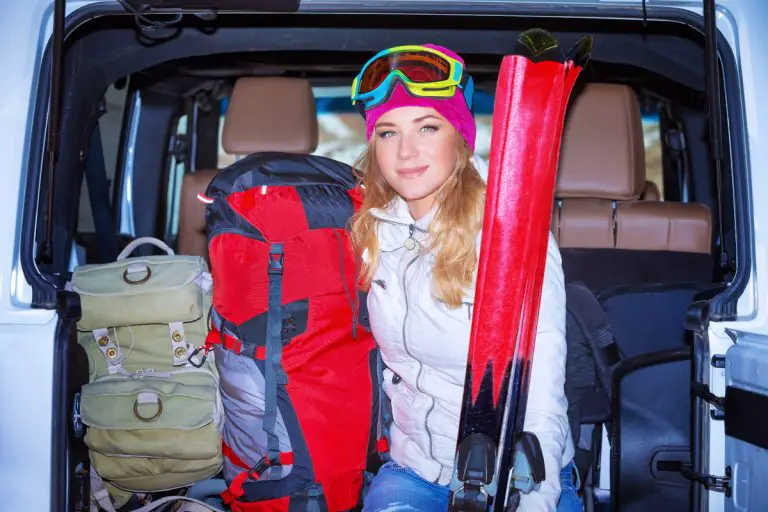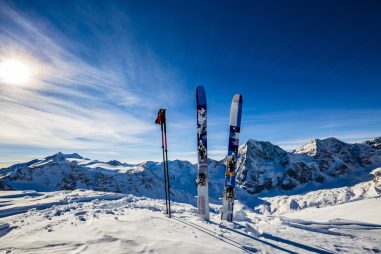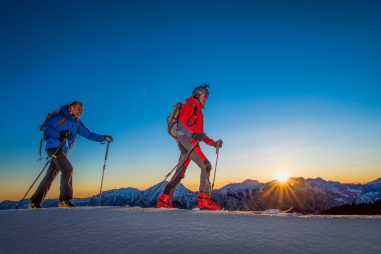Backcountry skiing offers you fresh powder snow, tranquility, and a real adventure. But the elements require preparation if you want to have a great time. And so aside from your backcountry skiing skills, you’ll need to prepare the right gear and equipment.
With the right gear, you’ll be able to ski with ease and be efficient in your movements. Meanwhile, what you’ll wear will protect you from the elements so you can be comfortable throughout your trip.
Because you’ll be heading into an isolated area, preparation will make all the difference. So make sure you have a good experience by knowing what gear to use and bring for backcountry skiing.
What Equipment Do I Need for Backcountry Skiing?
Before heading out for your backcountry skiing trip, you’ll need the right skiing equipment. Aside from the basic ski setup, you’ll also need to have safety gear, clothing, food, water, and other tools.
All these are critical if you want to have a fun and safe trip.
How Do You Pack for Backcountry Ski Touring?
You’ll need to know how to pack your things for a backcountry skiing trip. This isn’t like walking in the park where you can just stuff everything in your bag and go.
The best way to pack everything is by using a skiing backpack. They come in various sizes to choose from. Compared to a hiking pack, backcountry backpacks have the following features:
- Ski or Snowboard Carry: When backcountry skiing, there will be times that you may need to remove your skis. This feature allows you to strap your skis or snowboard without having to carry them with your hands.
- Avalanche Safety Gear Storage: During an avalanche, you’ll be able to get your shovel and probe easily. This way, you don’t waste any time in a critical situation.
Aside from picking the right size, you’ll also need to know how to pack your things efficiently. This way, all the important items are within reach, especially in emergencies.
In your bag, you need your food, water, avalanche and communication equipment, and first aid kits. You’ll also need extra clothing.
What Size Backpack Do I Need for Backcountry Skiing?
Now that you know what a backcountry pack is, here are the different available sizes and when to use them:
- 10 to 20 L: This size is ideal if you have the luxury of a lift or a helicopter to bring you up.
- 20 to 35 L: For longer day tours, this backpack size is enough to carry all that you need.
- 35 to 55 L: If you’re going to camp for a day or two.
- 60 to 70 L: This is for longer trips that require you to bring a tent and cooking equipment, among other things.
Do You Need Special Boots for Backcountry Skiing?
In backcountry skiing, you need a special boot that will work for touring and for downhill skiing. This is why backcountry skiing boots are designed to have two modes: downhill and touring.
When touring, your boots are detached from the heel. This makes them function like backcountry skiing boots. You can walk or ski on flat terrain or climb hills while maintaining your balance.
Once you’ve reached the top, the boots can attach themselves to the heel for downhill skiing. This gives you more control and speed than how it is with alpine skiing.
Do You Need Special Bindings for Backcountry Skiing?
In backcountry skiing, not all bindings and skis are compatible with each other. So you’ll need to make sure you’ll be using bindings made for your ski.
Bindings come in two types: tech and frame.
Tech bindings attach your boots to your skis using pins. They’re lightweight and ideal for those who do plenty of uphill touring.
Meanwhile, frame bindings connect your boots using a rail. This makes it look like your traditional alpine ski binding. These bindings are heavier and are recommended if you prefer downhill skiing.
Do You Need Touring Bindings for Backcountry Skiing?
You definitely need touring bindings if you plan to go backcountry skiing. With touring bindings, your heels are detached when skinning uphill. This allows you to move naturally as you go up.
When it’s time to ski downhill, the bindings lock your heels to the ski. This makes it possible for alpine skiing downhill.
What Are Backcountry Ski Bindings?
Without bindings, it will be impossible to ski. Backcountry ski bindings lock your boots to your ski. But they also release you from your skis in certain situations, like when you fall.
They’re different from regular alpine ski bindings for two reasons:
- They allow you to walk or go uphill because your heels are detached.
- They allow you to go alpine skiing by locking the heel to your boots.
How Do Backcountry Ski Bindings Work?
The toe part is where backcountry bindings connect to your skis. This leaves the heel detached so your feet can move naturally while climbing.
But when it’s time for downhill skiing, backcountry bindings will lock your heels to your ski. This way, you can ski fast and aggressively like with alpine skiing.
Backcountry ski bindings are either tech or frame bindings. How they connect to your skis is what differentiates these two systems.
Do You Need Skins for Backcountry Skiing?
Skins are another necessary gear. Also called climbing skins, they’re strips of materials that you attach under your skis.
These synthetic materials are responsible for giving you traction when climbing. Because of skins, you won’t slide back down, giving you more control when traversing slopes.
What Are Skins in Backcountry Skiing?
Skins are strips of materials that prevent your ski from slipping during climbs. How the material holds onto the snow is what makes this possible. But when moving forward, the synthetic materials flatten so you can glide.
Some skins cover the entire bottom while some only cover the middle section. Skin materials look like animal fur or scales and are designed to grip the snow. As a result, you move fast and are more efficient with your energy spending. More importantly, you don’t have to worry about slipping backward.
Here are the types of skin materials available in the market today:
- Synthetic: Often made of nylon, these are more durable and offer excellent traction. The downside is they don’t give you a good glide compared to other materials.
- Mohair: These are made of Angora Goat hair which makes them great for gliding. Unfortunately, they wear out much faster.
- Blend: It’s a combination of both nylon and mohair. Choose this skin if you want a balance of traction, glide, durability, and overall value.
How Do Backcountry Ski Skins Work?
Backcountry skins grip the snow to give you traction and prevent you from slipping. Whether they’re synthetic fur or scales, the skin grips the snow when you push off to move forward.
But some skin materials can offer better glide too. These types of skins flatten when sliding forward which is helpful during steep climbs. With this, you can have more efficient movements, thereby conserving your energy.
How Do You Use Backcountry Skins?
Most backcountry skins come in a rolled, long strip when purchased. You’ll need to cut and trim the skin to fit your ski’s shape while ensuring the metal edges remain exposed. However, you’ll also find pre-cut skins that are compatible with specific skis.
To use backcountry skins, you’ll need to attach them to the bottom of your skis. Once attached, you can now use your skis and experience the advantages of backcountry skins.
How Do You Put Skins on Backcountry Skis?
Backcountry skins have two parts: the actual skin and the sticky part on the other side. It goes without saying that it’s that sticky part that you should attach to your ski.
Attaching the skin is easy. Hook the cable loop found at the top of the skin to the tip of your ski.
Once hooked, you can now lay the skin on the ski by pressing down along the length of the skin. Make sure the skin properly sticks to your ski.
At the end of the skin, you have a clip that you’ll attach to your ski’s bottom tip. Press down firmly to ensure a tight fit so that the skin will remain in place.
How Do You Take Care of Backcountry Skins?
Your skins will impact your backcountry skiing experience. That’s why it’s important to take care of your skins. They’re also designed for multiple uses, and so improper maintenance will cost you a pretty penny.
To take care of your skins, you need to keep them clean and stored properly.
How Do You Clean Backcountry Skins?
When you start getting inconsistent performance from your skis, that’s a sign to clean your skins. You can remove dirt or snow by using skin cleaners. These products were specifically made to clean skins without damaging the adhesive.
Avoid using regular household cleaning products. They won’t do the trick and can have a negative effect on the skin’s adhesive.
How Do You Store Backcountry Skins?
Storing your skins is pretty easy. However, you have to make sure that they’re completely dry. In fact, you should dry your skis after each skiing session.
Let the skins air dry at room temperature. Once completely dry, you can fold or roll your skins and store them in the bag they came with. If you don’t have that bag anymore, any bag will do as long as it protects your skins from dust and critters.
Once in the bag, store them in a cool, dry place and away from direct sunlight.
What Do You Wear to Backcountry Skiing?
When it comes to backcountry clothing, you need protection and comfort. Because of the extreme climate, you need to wear jackets and pants that insulate you from the cold. This will prevent you from freezing or getting frostbite.
But at the same time, you can’t wear something too warm. You still need to move comfortably and allow your body to release the heat generated while skiing.
Thus, you need to layer properly to achieve this balance. Aside from your jacket and pants, the following are also essential:
- Socks
- Gloves or Mittens
- Beanie
- Helmet
- Goggles or Sunglasses
How to Layer for Backcountry Skiing
Layering is a necessary technique if you want to feel comfortable out in the cold. Here are the different layers and the recommended fabric for each.
Base Layer
This layer should be made of thin, moisture-wicking, and quick-drying material. Because it’s the closest to your skin, it will absorb all the sweat and heat your body generates.
But because it removes the sweat from your skin, it will help keep you dry and prevent you from feeling too cold.
If it’s not too cold out, you can opt for a thin base layer. Otherwise, you can go for the thicker fabric for more warmth.
Mid Layer
Mid layers often come in the form of light jackets made with technical fabric. It should be thick enough to protect you from the elements. But they should also be highly breathable to prevent you from overheating.
If you tend to sweat more, you should be able to easily remove this layer so you can cool down.
Shell Jacket
A shell jacket’s main purpose is to protect you from strong winds or heavy snow. There are two types of shell jackets – hard shell and soft shell.
Hard-shell jackets offer more protection from the bad weather but are not as breathable. Meanwhile, soft-shell jackets are best if you want breathability. This helps with better body-temperature regulation.
These also come in technical fabrics which are windproof and waterproof.



